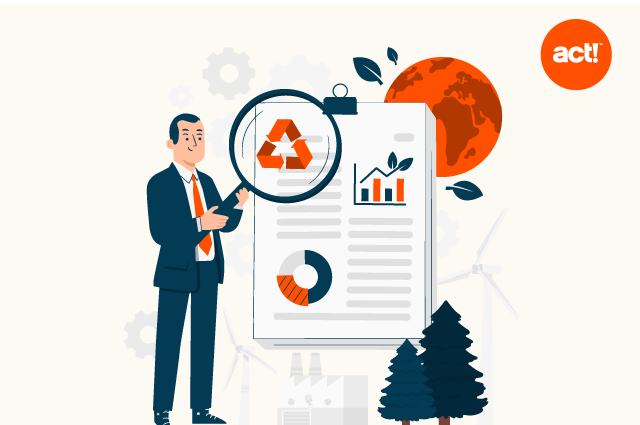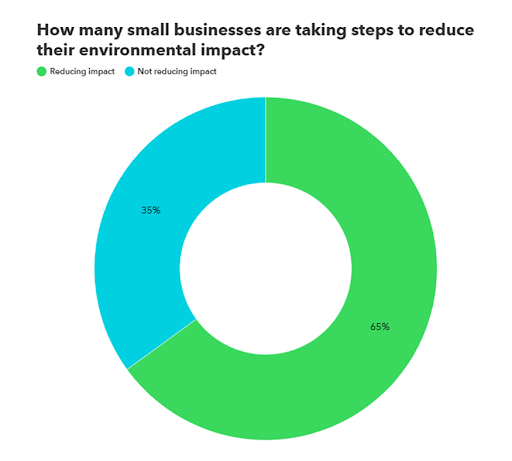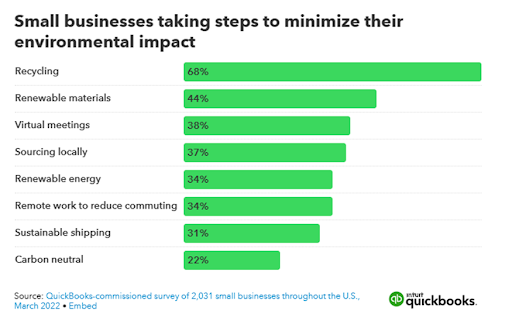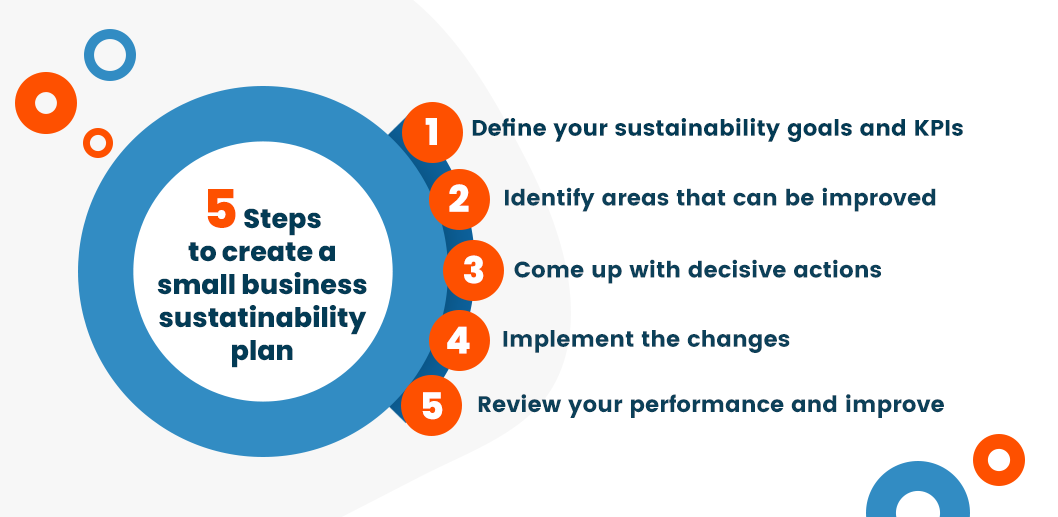
The year 2022 was among the warmest years on record since 1880, with temperatures reaching an average of 0.86°C (1.55°F) above the norm for the 20th century. The reason? Human civilization’s continuous pursuit of growth.
And it’s for this reason that you need to start thinking of sustainability, especially as a small business owner pursuing business growth.
In fact, 65 percent of small businesses are already implementing sustainable business practices to reduce their environmental impact.

Image via QuickBooks
From recycling and using renewable materials in an effort to reduce landfill waste, to facilitating virtual meetings and locally sourcing resources, they’re implementing a host of techniques in their sustainability strategies to further their sustainable growth.

Image via QuickBooks
By going sustainable, you don’t only help the environment; you also become more attractive to consumers who value social responsibility and consider it critically important in business. Case in point — 61 percent of consumers in the US say sustainability is their main consideration while purchasing.
And guess what? Consumers are willing to pay up to 25 percent more for sustainable products. That means it’s possible to go sustainable without hurting your bottom line.
So, how do you go sustainable? The first thing you need to do is create a sustainability plan.

What is a business sustainability plan?
In simplest terms, a business sustainability plan is a roadmap that an organization develops and follows to reach environmental and financial sustainability. It guides how the organization sources materials, develops products, and distributes them.
The plan is aimed at doing business and growing your company without any negative impact on the environment, society, and community. It could include things like recycling, reducing waste, not using toxic materials, and upcycling, among other things.
Having this plan in place is important to ensure you can hit achievable goals for sustainability in your small business and create a positive impact.
5 Steps to create a small business sustainability plan

Knowing what you’re aiming for with a sustainability plan is critical, but it’s equally important to understand best practices for creating one. Here’s the step-by-step process you can follow to learn how to create a sustainable business.
1. Define your sustainability goals and KPIs
Like a marketing plan, it’s crucial to identify solid sustainability goals from the beginning. These goals can help you align your efforts in the right direction. Without them, your sustainability practices will likely translate into nothing more than a marketing ploy.
The other reason to set goals is that they’ll determine your key performance indicators (KPIs) and related metrics for measuring your progress. Some sustainability goals and their related KPIs could be:
- Reduced utility use: Energy use, water usage
- Waste reduction: Water waste, paper waste, plastic waste
- Reduced carbon emissions: CO2 released by manufacturing or contributed by the supply chain
- Reliance on local communities: Support provided to locals, goods sourced from locals, involvement in environmental causes
Whatever the goal, ensure it’s attainable, specific, and measurable.
2. Identify areas that can be improved
If you already have a set of processes in place, you need to start analyzing them from scratch. This can help you understand where you’re lagging in terms of sustainability.
From your vendors and supply chain to manufacturing process and administration, go through every department. You can then identify every spot where legacy processes can be replaced with more sustainable solutions.
For instance, if you’re importing most of your materials, you could start looking for local vendors. This can significantly reduce your carbon footprint. Similarly, if you’re using plastic packaging on your products, you could replace it with recyclable or biodegradable materials.
You won’t be able to identify a plan of action without first finding problem areas, so it’s essential to thoroughly brush through your processes at this stage.
3. Come up with decisive actions
After identifying the areas that require action, you should develop a plan outlining all the innovative solutions you’ll employ to become sustainable.
Use new technologies
Offices in the US use 12.1 trillion sheets of paper each year, making this an easy target for deploying relevant technology to reduce consumption. For instance, by using a customer relationship management (CRM) like Act!, you eliminate the need to keep paper records of customers. Team collaboration and documents can also go completely paperless.
In addition, marketing automation enables you to easily create digital communications and assets including emails, landing pages, QR codes, and forms to communicate with your prospects and customers and capture their valuable information without the use of paper, or increasing carbon emissions with hardcopy mail deliveries.
You can also opt for hybrid or remote work arrangements to reduce your carbon footprint as employees won’t have to travel to work daily in gas-guzzling vehicles. And the right tech can smooth this transition.

Involve employees
Make sure you involve employees in this process. Invite them to make suggestions that can improve your sustainability. This will also make them stakeholders in your mission to achieve energy efficiency and reduce waste.
Improve energy and waste management
Consider your existing processes and find ways to make them more environmentally friendly. For instance, you could install solar panels to offset your power usage and go renewable or use energy-efficient LED light bulbs. Similarly, you could set up a composting plant or develop a water reuse strategy.
4. Implement the changes
The actions you intend to take must be implemented correctly for maximum impact. Start by tweaking your policies to ensure they align with the new sustainability goals. If you opt for a hybrid workspace, you’ll have to develop new policies that govern how employees should work remotely.
It’s critical to clearly communicate the actions you’re going to take. Educate your employees on sustainable practices to get them on the same page. Train them so they can work in unison to bring your vision to life. You might also have to examine your organizational structure to support your sustainability initiatives. This could involve assigning more roles to employees or hiring new ones.

5. Review your performance and improve
You must regularly review your sustainability plan‘s goals and assess where you stand using the KPIs you chose. This can help you determine whether you’re on your path to meeting your goals. Accordingly, you can tweak your action plan to improve it further to achieve your goals.
The review process doesn’t need to be time-consuming. It could be as simple as comparing your current month’s water usage with the previous month’s and evaluating any necessary adjustments.
Next steps toward sustainability
Consumers are inclined to buy from sustainable brands, meaning sustainability is no longer a choice but a necessity for small businesses. And a sustainability plan is the stepping stone to creating an eco-conscious culture in your business.
Want to learn how Act! can help transform your path to sustainability? Start your 14-day free trial now.





